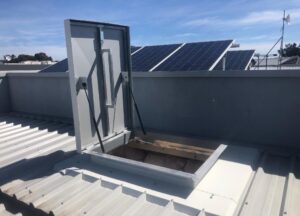Roof Access hatches design provide safe ladder or stair access to steel building rooftops, and come in galvanised steel or aluminium with mill finish finishes.
Hatches should be installed to reduce the need for exterior wall ladders that pose security risks and damage roof equipment and materials. When specified properly, they will meet various safety standards.
Insulation
Hatches must be insulated to prevent frost and condensation accumulation, high temperatures and noise levels when open, fire resistance and explosion resistance, supporting equipment weight, secureness against accidental closing, collective protection systems that help avoid falls from roof, as well as fire safety requirements. In order to meet all these criteria, hatches should also include secure attachment points to avoid unnecessary opening/closing events, fire and explosion resistant construction materials and fireproof linings, non-combustible interior finishes, noiseless operation when open as well as collective protection systems which help prevent accidental falls from roof.
Dependent upon how often and for what purposes individuals access the roof area, hatch sizes vary to accommodate comfortable use. If maintenance personnel need to transport heavy tools regularly through their hatches, larger models with service stair should be considered as more convenient alternatives.
Certain environments necessitate special consideration when building hatches, such as highly corrosive environments and coastal regions that experience extreme weather. Furthermore, such conditions often necessitate high security features like bullet-resistant views and deadlocks to safeguard these environments from theft.
Safety
Roof Access hatches design may provide facility maintenance workers with an easy way to access rooftop equipment, but they pose several potential safety risks. When left open during roof work on a building rooftop, for instance, they create an unprotected fall hazard; OSHA regulations mandate that employees working above 3 meters need some form of personal fall protection device.
Hatches should be designed for safe operation and easy closing and opening, with repeated use withstand repeated rough handling from maintenance professionals. A secure latch should also be included to avoid accidental opening while remaining closed during normal operations.
Building owners and managers must determine how best to safeguard roof access hatches while fulfilling OSHA standards and liability concerns. There are various options available, such as safety gates or guardrails, which they may use to find the solution most suited to their structure.
Design
 Your frequency and reason for accessing roof areas will determine which hatch type and opening size would best serve your purposes. For instance, maintenance workers bringing heavy equipment onto the roof might find ship stair access hatches with larger opening sizes more suitable than ladder access hatches.
Your frequency and reason for accessing roof areas will determine which hatch type and opening size would best serve your purposes. For instance, maintenance workers bringing heavy equipment onto the roof might find ship stair access hatches with larger opening sizes more suitable than ladder access hatches.
Hatch design can play an essential role in providing a safe working environment. For instance, hatches with uniform lift assistance allow easy one-handed operation and prevent the cover from closing under its own weight, potentially causing injury to workers on roofs or stairs. Also important: the inclusion of hold-open arms which prevent accidental closure when workers are on roofs or stairs.
Acoustic and thermal properties of panels can also be crucial. A hatch with a composite cover provides sound insulation equivalent to that found in standard conversations and energy savings through efficient thermal performance, while depending on their composition they may even offer load bearing capabilities and increased safety.
Installation
Installing a roof access hatch requires using protective equipment and adhering to all fall protection regulations to keep workers safe during roof work or fire emergencies. Failure to observe these standards could result in steep fines; so be sure that when selecting an access hatch that fulfils all criteria.
Several factors will play a part in selecting an ideal roof access hatches design. For instance, depending on its use and purpose in an office building and how frequently people need access to its roof space can dictate which design best meets those requirements. Workers carrying heavy tools and supplies require a larger double-cover hatch with stair access; frequency of roof visits could also have an impactful effect.
Some hatches feature additional security measures that increase protection, such as interior and exterior padlock hasps, or customised features like keyed cylinder locks or contact switches for alarm systems. All these features aim to keep the hatch closed at all times while it’s not being used, helping prevent unauthorised access or theft from taking place.
